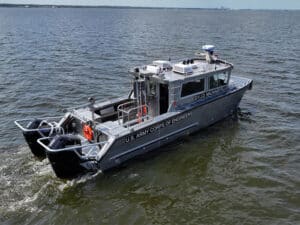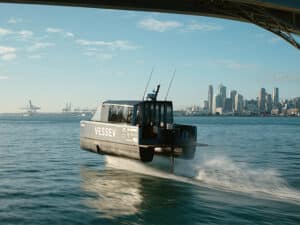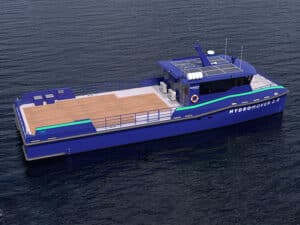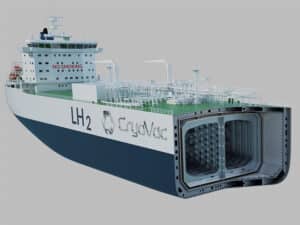
World’s largest containership makes first stop in Europe
Written by Marine Log Staff DECEMBER 14, 2012—The Port of Hamburg Hamburg was the first continental European port of call on the maiden voyage of the mega containership CMA CGM Marco Polo. The 16,020-TEU boxship was handled at the HHLA Container Terminal Burchardkai.
DECEMBER 14, 2012—The Port of Hamburg Hamburg was the first continental European port of call on the maiden voyage of the mega containership CMA CGM Marco Polo. The 16,020-TEU boxship was handled at the HHLA Container Terminal Burchardkai.
The new flagship of French shipping company CMA CGM, the Marco Polo is currently the largest capacity containership in the world. It has a length of 396 meters long and beam of 53.6 meters.
The ship sails the FAL1 service on the most important international trade route between the Far East and Northern Europe, which is the most important shipping region for the Port of Hamburg.
DISTINCTIVE SHIP OF 2012
With the Marco Polo, CMA CGM has once again taken on a pioneering role in the development of ship sizes. It is the first of three ships in this class that will be named for great explorers.
Beyond its sheer size, the CMA CGM Marco Polo incorporates some of environmentally friendly technology. For example, the ship is fitted with a twisted leading edge rudder that improves the hydrodynamics of the vessel and reduces energy consumption and CO2 emissions. Its electronically controlled engine consumes an average of 3 percent less fuel and 25 percent less lube oil. The optimized hull design reduces energy consumption even further.
The innovative CMA CGM Marco Polo was named one of Marine Log’s Distinctive Ships of 2012. The other award-winning vessels included:
Al-Idrisi, hopper suction dredger, built by STX Offshore & Shipbuilding
American Phoenix, Jones Act product tanker, completed by BAE Systems Southeast Shipyards
Basle Express, containership, built by Hyundai Heavy Industries Ltd. Co.
Bneider, product tanker, built by Daewoo Shipbuilding & Marine Engineering
Brightoil Gravity, Very Large Crude Oil Carrier, built by Hyundai Heavy Industries
Elka Leblon, shuttle tanker, built by STX Offshore & Shipbuilding
Glovis Challenge, RO/RO car carrier, built by Hyundai Heavy Industries
JS Amazon, Ultramax Crown63 bulk carrier, built by Sinopacific Shipbuilding’s Yangzhou Dayang Shipyard
Nave Cassiopeia, product carrier, built by Sungdong Shipbuilding & Marine Engineering
PTSC Bien Dong 01, Floating Storage Offloading vessel, built by Sungdong Shipbuilding & Marine Engineering
Sonangol Porto Amboim, crude oil carrier, built by Daewoo Shipbuilding & Marine Engineering Co. Ltd.
STX Arborella, wood pulp carrier, built by STX Offshore & Shipbuilding

PORT OF HAMBURG PREPARED FOR LARGER SHIPS
Larger ships increase the ecological quality of the transport chain – even more so when they sail far inland and their cargo is then transported by feeder ships or rail further inland in Europe. With feeders accounting for a high 25 percent of seaborne handling and a rail share of more than 70 percent in land-based long-distance traffic, the HHLA container terminals in Hamburg build ecologically outstanding transport chains. Hamburg’s land routes towards Central and Eastern Europe are also 250 to 450 kilometers shorter than for the westerly ports in the North Range.
“Thanks to its good hinterland connections to Central and Eastern Europe and the excellent trans-shipment link to the Scandinavian and Baltic regions, CMA CGM made a
conscious decision that its ships, such as the CMA CGM Marco Polo, should call at Hamburg. We have to bring our ships as close as possible to our customers, who appreciate the Port of Hamburg as much as we do. The delay in the dredging of the river Elbe makes it more difficult for us to enable dependable handling, because even now we can only sail upriver under restrictions due to very narrow tide windows and the limited draft for ever-larger vessels,” explained Reinhard Peschel, Managing Director of CMA CGM Deutschland GmbH.
The cooperation between everyone involved at the Port of Hamburg and on the river Elbe is being intensified in order to optimize the handling of a growing number of ships with a capacity of more than 10,000 TEU now and in future. “For us, this entails close collaboration with the Port Control Center in Brunsbüttel, the harbor master’s office of the HPA and the pilots on the river and in the port. To improve our traffic services even further, we are adding staff at the Feeder Logistics Center, which we operate jointly with Eurogate, in order to support the coordination of mega-ship traffic from there in future,” said Dr. Stefan Behn, HHLA Executive Board member for the Container Segment.
To boost the performance of the CTB and develop its capacities in line with demand, Hamburger Hafen und Logistik AG (HHLA) has invested some EURO 400 million in its largest terminal over the past few years. One focus was on the modern mega-ship berths with tandem gantry cranes that can load or discharge four 20-foot containers or two 40-foot containers in a single movement. “We have specifically prepared the Burchardkai for handling the latest generation of container
mega-ships. Continuous innovation and the great dedication of our staff keep our terminals at the top of the European rankings,” added Dr. Behn.
“The Port of Hamburg is an attractive hub for the really big ships, as is now shown by the first visit of a 16,000 TEU vessel. To ensure that it can fulfill this key function even better in the future, I am hoping for a swift decision from the Federal Administrative Court on the start of work to dredge
the shipping channel,” explained Claudia Roller, CEO Port of Hamburg Marketing. Roller observes a growing number of Ultra Large Vessels in the Port of Hamburg.
In 2011, vessels with a length of more than 330 meters and/or wider than 45 meters called 894 times at the port.





Leave a Reply
You must be logged in to post a comment.